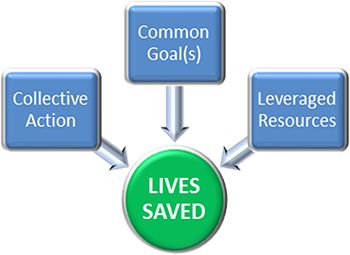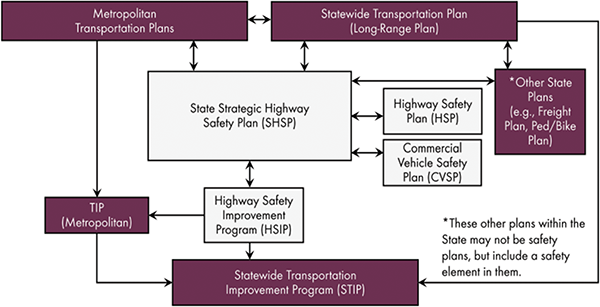The Maine practice is discussed after the following introduction about SHSP integration.
Other states in this SHSP Integration Noteworthy Practices series: DE, ID, MD, ND, WA
Introduction to SHSP Integration
The Strategic Highway Safety Plan (SHSP) is a statewide-coordinated safety plan that provides a comprehensive framework for reducing the number of deaths and serious injuries on all public roads. In each State, the SHSP identifies the State's safety goals, objectives and key emphasis areas. It is intended to serve as an ‘umbrella’ plan that is integrated into other State transportation plans and guides the State's roadway safety investment decisions.
Integration Defined
Integration is the act of bringing together or incorporating various parts into a whole. Integration is relevant and important to a State's planning process because every State has numerous transportation plans; each one potentially addressing safety in a different way. The SHSP is the mechanism to bring these safety “parts” together to form a consistent and “whole” safety program for the State.
The Purpose and Benefits of Integration
The purpose of integration is to coordinate and focus the State's roadway safety efforts to maximize the State's ability to save lives.
Through integration, the safety needs of the State can be addressed more strategically and resources can be shared more effectively. As illustrated in Figure 1, integration encourages State partners to strive toward common goals, collectively implement appropriate strategies and actions, share resources to meet or exceed the State's goals and objectives, and most importantly to save lives.

Other potential integration benefits include:
- The use of consistent data and analysis methods.
- Improved allocation of resources to more effectively produce safety improvements.
- Improvements to safety culture across State, regional, and local agencies.
- A reduction in the administrative burden on States and local agencies.
Integration of Plans and Processes
State transportation plans and programs that the SHSP should be integrated with include the Statewide Long Range Transportation Plan (LRTP), Statewide Transportation Improvement Plan (STIP), State Highway Safety Improvement Programs (HSIPs), the Commercial Vehicle Safety Plan (CVSP), the Highway Safety Plan (HSP) Metropolitan Transportation Plans (TIPs), and various modal and regional transportation plans. The relationship of these plans is illustrated in Figure 2.

An integrated SHSP positions the State DOT and its safety partners to collectively address the State's safety challenges on all public roads through coordination and consistency among with the following State and regional plans and programs:
- LRTPs to promote a long-range vision that incorporates safety priorities.
- HSIP projects to be consistent with the SHSP emphasis areas and strategies.
- STIPS/TIPS to align programming of projects with SHSP strategies and countermeasures.
- CVSPs to facilitate exchange and collaboration between the commercial motor vehicle safety community and the broader safety community.
- HSPs to ensure a consistent, data-driven approach to improving highway safety, especially in SHSP emphasis areas.
In addition, the SHSP should integrate with city and county planning processes to ensure consideration of safety concerns on all road types.
SHSP Integration Indicators
Indicators that the SHSP and other transportation plans and processes are integrated include the following:
- Other transportation plans incorporate elements of the SHSP and include consistent and supporting safety goals, performance measures, objectives, and strategies.
- The priorities and goals of other transportation programs and plans are considered when developing the SHSP.
- Safety partners have access to and use of common safety data, analysis, and methods for determining safety priorities.
- The SHSP is developed with sustained input from disciplines and agencies representing the 4Es of safety (engineering, enforcement, education, and emergency medical services).
- Safety partners assist in the implementation of SHSP strategies.
- SHSP stakeholders and experts are included in other transportation planning processes.
- SHSP priorities and strategies are considered in project prioritization and programming.
- Various sources of funding are used to achieve safety goals.
- Progress towards safety goals is measured jointly and regularly.
Maine
Background
The Maine SHSP brings together many state agencies pursuing traffic safety interests plus other safety advocates. Together they address Maine's leading traffic safety concerns in a coordinated way to maximize effectiveness and efficiency of achieving improvements in target areas.
SHSP Integration Practices
Collaborative Development
The Maine Department of Transportation (DOT) and Department of Public Safety's Bureau of Highway Safety (BHS) led an update of the SHSP in 2012. The 2012 SHSP identifies eight lead focus areas and six additional strategic areas. Champions from State, local and nonprofit agencies are identified for each of the 14 focus areas. A particular emphasis was placed on identifying local law enforcement champions to encourage local engagement in the plan. Champions are responsible for regularly convening working groups, reviewing data, and developing objectives and strategies, leading the implementation of strategies, and reporting progress. Strategies to bring about safety improvement include Engineering, Enforcement, Education/Public Outreach, and Emergency Services.
Common Goals, Strategies, and Measures
Maine's SHSP is closely tied to the Highway Safety Plan (HSP). The BHS and Maine DOT's Office of Safety work closely together to ensure that their efforts are coordinated. As a result, the goals expressed in the SHSP and HSP are common goals arrived at from reviewing the same data. Performance measures and targets included in the SHSP for behavioral emphasis areas are drawn from those defined in the HSP.
Coordinated Implementation
The Maine Transportation Safety Coalition (MTSC) provides another channel for coordinating safety efforts. Members of the coalition meet monthly to review data and coordinate efforts towards common goals. The MTSC helps to promote and integrate SHSP goals and strategies across the Maine safety community. The MTSC also helps to ensure that the major safety agencies in Maine are all communicating the same message about highway safety.
Outreach and Communication
The partnerships among Maine's safety agencies are reinforced through consistent communication and collaboration. Individuals in key safety agencies have made the effort to build personal relationships over time. Mechanisms like the SHSP update, the implementation process and the MTSC help to reinforce those personal relationships that are vital for ensuring that safety efforts are coordinated throughout the State.
Key Accomplishments
- Identified champions from State, local, and nonprofit agencies to lead emphasis area strategy development and implementation
- Closely aligned goals and performance measures in the SHSP with those in the Highway Safety Plan (HSP)
- Promoted the SHSP through the Maine Transportation Safety Coalition
See these other SHSP Integration Noteworthy Practices:
Contact
Duane Brunell
Maine Department of Transportation
(207) 624-3278
Duane.Brunell@maine.gov
